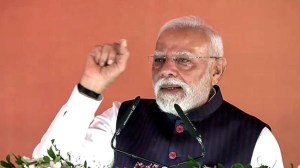More plans than funds worry Ram Naik no end
SATARA, SEPT 16: Union Minister of State for Railways Ram Naik is a worried man, despite being in charge of, ``the biggest landlords amon...

SATARA, SEPT 16: Union Minister of State for Railways Ram Naik is a worried man, despite being in charge of, “the biggest landlords among the ministries,” as he loves to call his favourite portfolio, the Railways.
At the heart of his worries lie the populist announcements made by previous Railway ministers. Be it establishing the Pune railway division or constructing a railway bridge over the Ganga at Patna, Naik frets over how to fulfill the overwhelming aspirations of the people. Because he knows that a petty budgetary allocation of Rs 1,200 crore per year will not satisfy everyone.
“It will take nearly 50 years more to fulfill the promises made. Not to forget a whopping requirement of Rs. 49,000 crore to see these projects through,” Naik told The Indian Express. Naik was here to attend the state executive conclave of the Bharatiya Janata Party.
Governments viewed railways as a commercial organisation, he said. However, he believes that the Union Government should make the budget keeping inmind areas where a railway link is a social necessity, though not commercially viable. “Be it the North-East or Jammu and Kashmir, the Union Government should be generous in providing funds,” he said.
With continuous cuts in expenditure (against 70 per cent in the Fifth Five-Year Plan period, expenditure on railways has decreased to a mere 18 per cent now), and the decreasing share of railways in freight carriage as well as passenger transport, Naik is concerned about the two extreme options: Continue at the same rate and risk losing a further market share, or launch on a high-growth trajectory.
Prioritisation is the only way out, he says, asked about the large number of projects undertaken. “Many new divisions like the one at Pune have been announced. This requires strong infrastructure. However, even the jurisdiction has not been marked for them. I can’t say when they will come into reality,” he said.
He thinks railway land should be commercially exploited, and cites the example of key Mumbaisuburbs. The land there would be best used by constructing commercial complexes over railway stations, he felt. Asked about losses incurred by Konkan Railway, he counters: “So what if it is incurring a daily loss of nearly Rs 1 crore. A Rs 3,000 crore venture will at least require four to five years to reach the break-even point.”
Addressing a janata durbar here, Naik announced that a new train on Kolhapur-Tirupati route will be flagged off on September 21.
But he cannot hide his concern. This has propelled him to raise the issue in a status paper that will discuss: Should there be a charter for the railways covering its role, financial objectives, investment policy, pricing policy, autonomy and delegation of powers and parliamentary control? Will it enable us to put the relationship between railways and the government on a strong and stable footing?





- 01
- 02
- 03
- 04
- 05


























